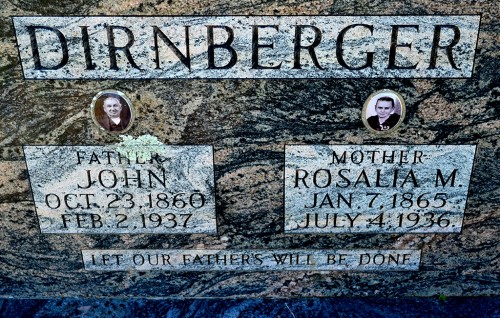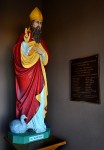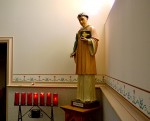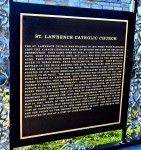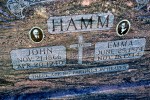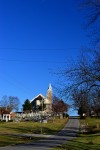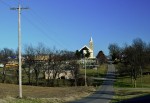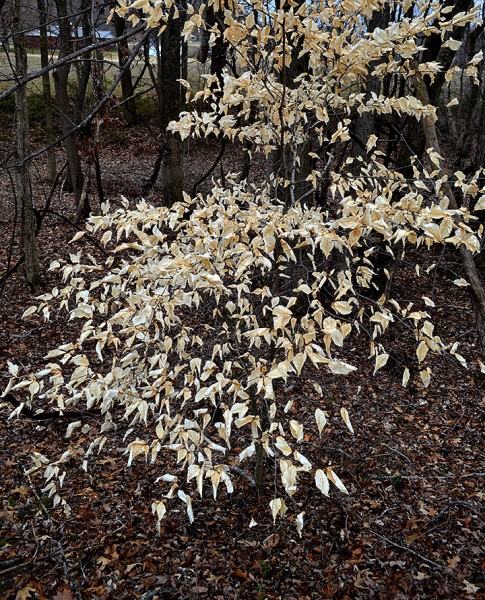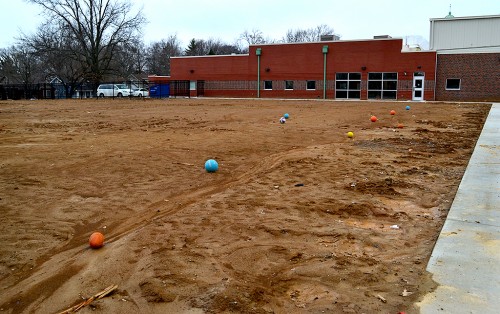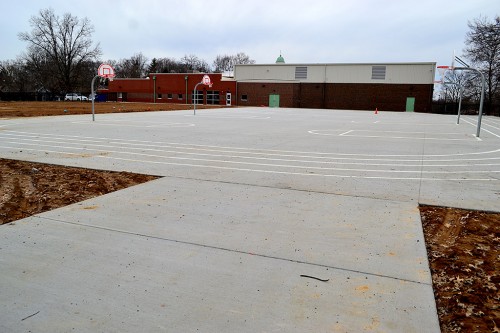 When I was living in Cape, I was a sucker for whatever new toy Nowell’s Camera would get in. I thought this half-frame camera was kind of neat. It was called a half-frame because it took two photos on a normal 35-mm frame of film.
When I was living in Cape, I was a sucker for whatever new toy Nowell’s Camera would get in. I thought this half-frame camera was kind of neat. It was called a half-frame because it took two photos on a normal 35-mm frame of film.
The good news is that you got twice as many photos per roll as a normal 35mm camera; the bad news is that you also got half the quality. Because of that, I hardly ever used it. If I was going to shoot something I cared about, I’d just as soon use a “real” camera.
Still, it was good for goofing around with. Based on other photos taken when my muttonchops were in that state of growth, I’d say this picnic was about 1970ish. It was chilly enough that I was wearing an old corduroy jacket I picked up at a charity sale held every year when the students left stuff behind in the dorms. It wasn’t all that warm, but I wore it everywhere.
Wife Lila is cute as bug
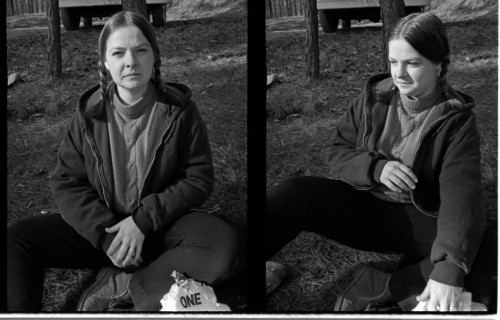 She’s warm enough in her sweater that she can leave her jacket open. Click on the photos to make them larger.
She’s warm enough in her sweater that she can leave her jacket open. Click on the photos to make them larger.
Fishing for fun, not food
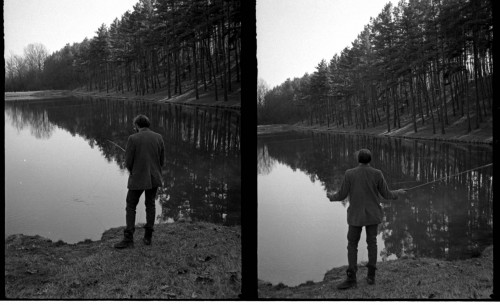
Buddy, boss and fellow Athens Messenger photographer Bob Rogers lived out in the country (you didn’t have to go very far out of Athens proper to be in the country) in a house with a pond in the back. I’d keep my fishing equipment on his porch and sneak off on a slow day to see if anything was biting. I’d park close enough to the pond to hear the police calls on my scanner so I could pretend to be working. If I got lucky, I’d leave the string in the water and a note telling Bob he was having fish for supper. This looks too big to have been Bob’s pond.
I’m wearing a pair of “fur”-like lined boots that I probably bought for all of about $12. I doubt that any sheep or other animals were harmed in the making of the footwear lining. They WERE warm and relatively waterproof. I wore them until the smell was so bad that flowers would wilt when I walked by. Plastic flowers.
How do you recycle something like that? Easy, I gave them to Brother David, who wore them for who knows how many years out in Oklahoma. If I ever read some scientific study that attributes Oklahomans’ lack of smell sensitivity to some kind of genetic anomaly, I’m going to have to speak up and tell ’em about David and my boots.
Beagle bait
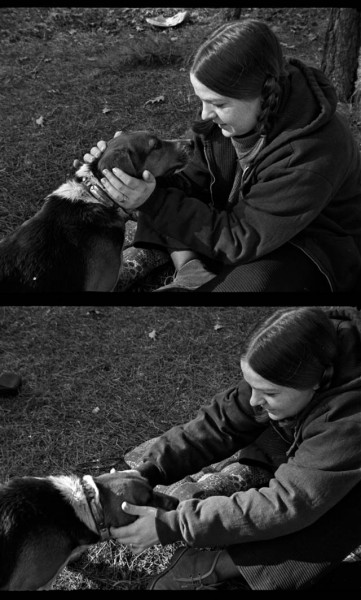 If there’s a beagle anywhere within miles of Wife Lila, they’ll make a beeline for her.
If there’s a beagle anywhere within miles of Wife Lila, they’ll make a beeline for her.
Don’t know what we had
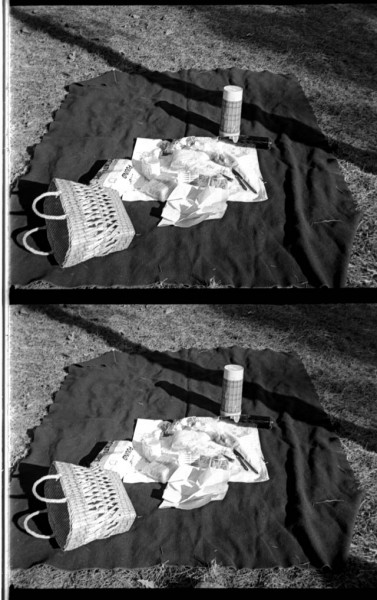 I tried to blow up the picture to see what we had on our picnic, but I couldn’t make out much. It looks like we had a glass bottle containing some kind of soft drink. I suspect that the beagle wound up with as much of our lunch as we did.
I tried to blow up the picture to see what we had on our picnic, but I couldn’t make out much. It looks like we had a glass bottle containing some kind of soft drink. I suspect that the beagle wound up with as much of our lunch as we did.
Best of cars, worst of cars
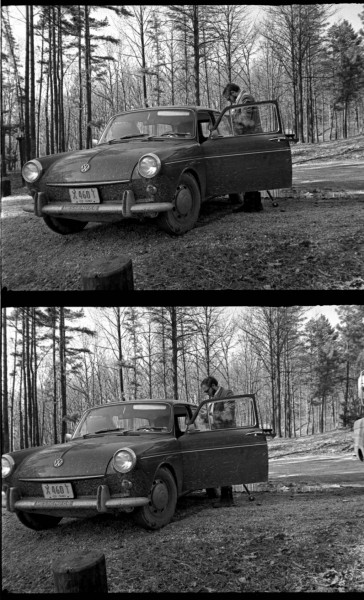
I bought this 1969 Volkswagen Squareback before I even tried to drive a stick shift. Lila had the task of teaching me how to shift gears on Athens’ steep hills. It was a long time before I could get away from having to keep one hand on the wheel and one hand on the emergency brake when I got stopped at the top of a hill. I learned very quickly where Bill Cosby’s “Go Around, Idiot, Go Around” bit came from.
It was a lemon from the time I drove it brand-new off the dealer’s lot and had it run out of gas two blocks away. We took it on a trip to Mexico. Not far out of Athens, I started smelling gas. Stopped at a service station where I was told the gas line had come loose in the back of the car (where the engine lived). Got down the road a bit and smelled gas again. The gas line was pulled loose from the tank (which was in the front of the car). Somebody had skimped on the amount of hose they had installed.
Air-cooled engine wasn’t
One night coming back from Columbus, we stopped for one of the red lights in Logan. The tiny town might not have had much, but it had lots of traffic lights, all synched to make you stop for each one. Apparently the brakes had been adjusted too tightly and were dragging. So long as I was cranking at highway speeds, the wheels would turn. When I slowed down for the light, they locked up solid. We had to wait by the side of the road for about an hour until they cooled down enough to release.
The biggest and baddest defect was that the air louvers that were designed to blow air back through the air-cooled engine were installed backward, causing them to suck instead of blow. I ended up selling the car with the engine disassembled and dwelling in a cardboard box.
It was a fun car to drive, though, and it was a nice small stationwagon-type vehicle. Too bad it was mechanically unsound and poorly put together. I’ll never forget those VW heaters. They depending on engine revs to blow the hot air. If you were in fourth to make time, your engine was turning over too slowly to produce heat. If you dropped down to third for heat, then you were over-revving the engine. You had to accept the fact that your carpet would turn to ice in about November and stay frozen until after the spring thaw.
A Valentine’s Day apart
I’m in Missouri and she’s in Florida for this Valentine’s Day. That doesn’t mean I’m not thinking about her. In my mind, she’s still the pig-tailed girl on the picnic. Then I look in the mirror and think, “What’s that cute thing doing hanging out with an old coot?”
 The first thing you see when you come into New Hamburg from the east, west or south (and, maybe the north, too) is the St. Lawrence Catholic Church.
The first thing you see when you come into New Hamburg from the east, west or south (and, maybe the north, too) is the St. Lawrence Catholic Church.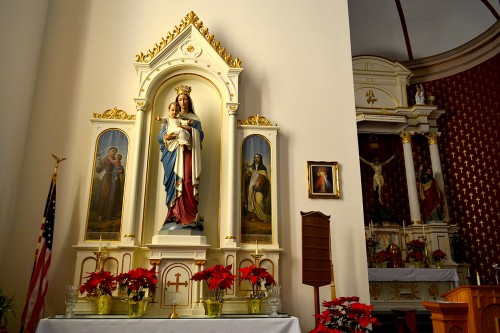 Shy Reader, who says she visited there practically every other weekend when she was growing up, shared an interesting tidbit: “The story I heard was that at the time the Catholic church was stripping its churches of statues, altars, etc., the folks at Hamburg took down the statues and hid them in barns, etc. Then, when the parish decided to restore the church, these idolic “geegaws” made their way back. Nice story, but not sure it’s true.”
Shy Reader, who says she visited there practically every other weekend when she was growing up, shared an interesting tidbit: “The story I heard was that at the time the Catholic church was stripping its churches of statues, altars, etc., the folks at Hamburg took down the statues and hid them in barns, etc. Then, when the parish decided to restore the church, these idolic “geegaws” made their way back. Nice story, but not sure it’s true.”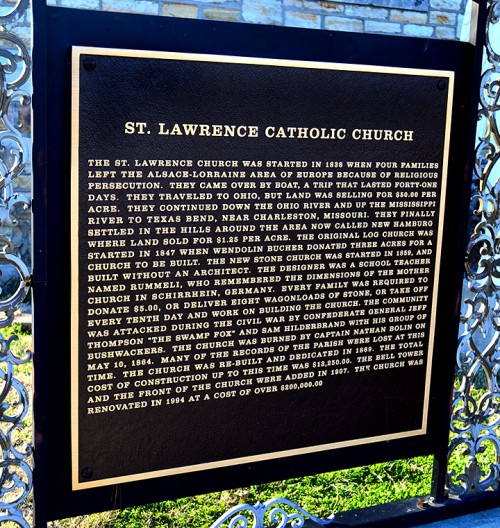 I like the part where it says the congregants were required to donate $5, or deliver eight wagonloads of stone, or take off every tenth day to work on building the church.
I like the part where it says the congregants were required to donate $5, or deliver eight wagonloads of stone, or take off every tenth day to work on building the church.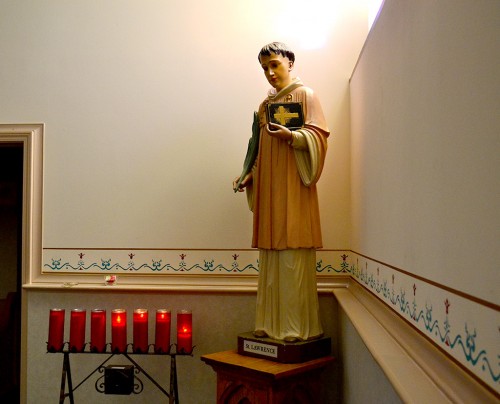 Edison Shrum, who wrote The History of Scott County, describes how the church was named:
Edison Shrum, who wrote The History of Scott County, describes how the church was named:
